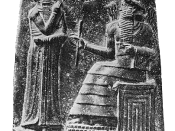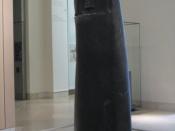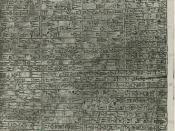Mesopotamia was the birthplace of the world's earliest known cities. The Mesopotamians developed one of the earliest writing systems, along with mathematics and astronomy. Later on developments of this great civilization include the wheel and the sail. They also divided time units into sixty parts which led to the concept of our 60 second minute and 60 minute hour. So this great culture has done so much for humanity, so lets look closely at what they left behind and see which artifact best summarizes their civilization. (1)To look through all the artifacts left behind by Mesopotamia and pick just one that best represents their civilization is hard; however the Code of Hammurabi seems to be the most important artifact that was left behind. The Code of Hammurabi is one of the earliest and best preserved law codes from ancient Babylon. The scene carved at the top of this massive stele shows King Hammurabi standing before the sun-god Shamash.
Shamash is most commonly associated with justice. This was due to the fact that the sun dispersed darkness just as Shamash would disperse injustice with his light. Hammurabi believed that Shamash was the inspiration that led him to gather the existing laws and legal procedures into a code. (2)Going back the image on the stele, Shamash is seated on a lavish throne before Hammurabi. His feet rest upon a scale-like pattern which is symbolic of the mountains in the east from which he rises at dawn. He wears a flounced robe and the crown which were characteristic of the Mesopotamian gods and goddesses. In his right hand Shamash is offering Hammurabi the rod and the ring, this was symbolic of kingship and is a gift from the gods. Hammurabi is standing with his hand raised in reverence of Shamash.
This artifact...


